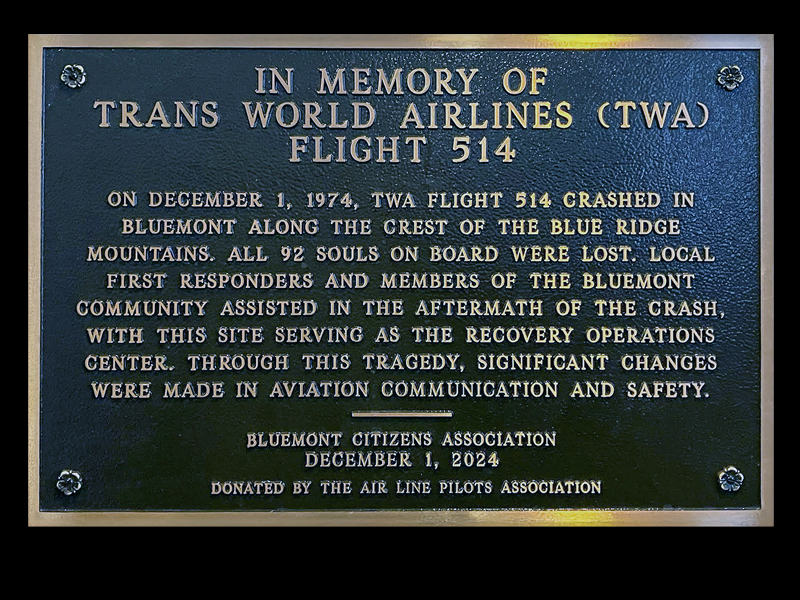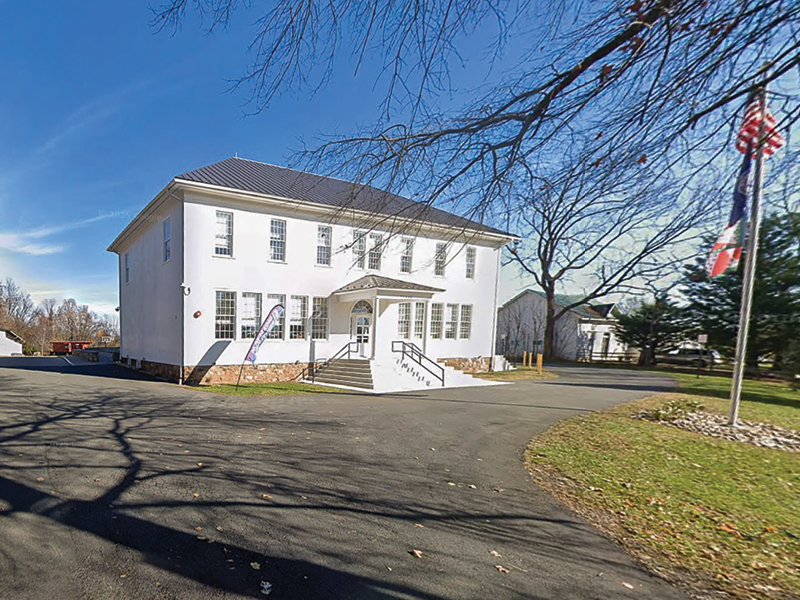The Legacy of TWA Flight 514: 50 Years of Reflection and Aviation Safety
Remembrance Ceremony Honors the Victims of Tragic Airline Accident
By Gavin Francis, Senior Aviation Writer

A bronze plaque commemorating the TWA Flight 514 accident was unveiled by memorial organizers inside the Bluemont Community Center.
Nearly 300 people, including family, friends, first responders, and community members, gathered in Bluemont, Va., on Dec. 1, 2024, to remember the victims of Trans World Airlines (TWA) Flight 514, which crashed on a nearby slope of Mount Weather on the crest of the Blue Ridge Mountains in December 1974, killing all 85 passengers and seven crewmembers on board. The commemoration, which took place on the 50th anniversary of the accident, was organized by members of the Bluemont Citizens Association with support from ALPA and other airline industry, aviation safety, and community groups.
Flight 514, a B-727 flying to Washington National Airport from Indianapolis, Ind., with a stop in Columbus, Ohio, was diverted to Dulles International Airport due to high winds and poor weather conditions. The flightdeck crew, composed of Capt. Richard Brock, F/O Leonard Kresheck, and S/O Thomas Safranek (the flight engineer), had received an approach clearance for a nonprecision instrument approach to Runway 12 at Dulles when the aircraft collided with terrain.
An investigation led by the NTSB later indicated that unclear communications about approach procedures and altitude restrictions was a factor in the crash. Air traffic control had cleared the flight to descend to 7,000 feet MSL before giving clearance for the approach while not on a published segment. The cockpit voice recorder suggested the crewmembers believed they were still under a radar-controlled approach segment and were authorized to descend to 1,800 feet MSL, the altitude at the first checkpoint for the published approach.
The Bluemont Community Center, a former school that served as a temporary morgue and base of operations for first responders and investigators after the accident, became the focal point for those who attended the emotional ceremony. A granite memorial in front of the building engraved with the names of all 92 victims was unveiled, ensuring that their memory will live on.

The Bluemont Community Center, a former school, served as the base of operations for first responders and investigators and as a temporary morgue after the accident.
“My wife Lisa and I moved to Bluemont in 2015 and were aware of the TWA accident that occurred years prior,” said Capt. Scott Seeberger (United), who along with his wife and their daughters, Meghan and Sarah, led the effort to organize the event. “We were surprised to learn that a memorial had never been held for the victims and their families. The crash occurred on private property, which is likely the reason why,” Seeberger remarked. “As the 50th anniversary of the accident approached, our citizens association knew we wanted to change this. The remembrance ceremony entailed over a year of planning, with a great deal of effort focused on contacting family members and first responders who were on the scene. Many of those in attendance commented that the event brought forth healing and closure after so many years.” Meghan Seeberger, an event planner in ALPA’s Strategic Member Development & Resources Department, used her professional expertise to assist in the planning and coordination of key aspects of the event.
NTSB Chair Jennifer Homendy acknowledged the grief of the victims’ families during keynote remarks she delivered to those who gathered for the ceremony, some of whom had never visited the area where the accident occurred. She also noted the transformative impact of the accident on aviation safety.
“Every advancement we’ve made in aviation safety carries the legacy of those we’ve lost,” she said. “The knowledge we drew from this tragedy has, without a doubt, made all of us safer. That means every person who sets foot on a commercial flight anywhere in the world.”
Homendy highlighted specific safety improvements that resulted from the accident, measures that have helped to prevent other accidents, and reaffirmed her agency’s commitment to preventing future tragedies. “Today, we renew our call for action—for the 92 lives lost on TWA Flight 514 and for the lives we can still save.”
ALPA played a role in supporting the remembrance ceremony, reflecting the organization’s commitment to honoring aviation’s past while shaping its future. The Association’s Executive Council approved a $1,500 donation for a bronze plaque commemorating the accident, which event organizers unveiled inside the Bluemont Community Center.
“The tragedy of Flight 514 was a turning point in aviation safety,” said Capt. Wendy Morse, ALPA’s first vice president and national safety coordinator. “It reminds us that behind every safety advancement are the lives and stories of those we’ve lost in too many tragic accidents. ALPA remains steadfast in continuing to advocate for improvements that make air travel safer for everyone.”
Local officials, aviation leaders, and family members of the victims also spoke at the event. Dr. Hassan Shahidi, president and CEO of the Flight Safety Foundation, emphasized the importance of safety reforms inspired by the accident. Phyllis Randall, chair of the Loudoun County Board of Supervisors, reflected on the significance of the memorial and how it serves as a lasting tribute to the lost lives.
Bridget Jones spoke about her grandparents, Brig. Gen. Roscoe Cartwright, one of the U.S. Army’s first Black generals, and Gloria Cartwright. Steven Onne reflected on the loss of his sister Susan, her husband James, and their son Benjy Applewhite. And Carl Zwisler remembered his parents, Carl and Mary Zwisler, who left a family of nine children without a mother or father when they perished on Flight 514. These stories brought a deeply personal dimension to the ceremony, reminding attendees of the human cost of the tragedy.
As a party to the investigation, ALPA provided subject-matter expertise critical to helping identify factors that contributed to the accident. Capt. Don McClure (Eastern, Dec.), who later served as a member of ALPA’s Engineering & Air Safety staff after retiring from Eastern in 1990, participated in the investigation. McClure had served as an ALPA safety volunteer in various positions, including local Air Safety chair, Central Air Safety chair (Eastern), chief accident investigator (Eastern), and chair of ALPA’s Accident Investigation Board. His contributions on behalf of ALPA in support of the NTSB’s investigation into Flight 514 helped highlight the need for clearer approach procedures and better terrain awareness tools for pilots.
The TWA Flight 514 tragedy had a profound effect on aviation, not just in the United States, but globally as well, prompting reforms that have saved countless lives in the years since the accident occurred. One of the most significant outcomes of the investigation was the mandatory installation of ground proximity warning systems (GPWS) on airliners. GPWS significantly reduced the risk of accidents from controlled flight into terrain. Other safety reforms included
- standardization of approach procedures, including clearer communication and documentation of minimum safe altitudes, reducing the likelihood of misinterpretation by flight crews.
- enhanced pilot training programs to ensure a better understanding of approach clearances and terrain awareness.
- development of the Aviation Safety Reporting System by the FAA and NASA to collect voluntary, confidential reports of possible safety hazards from aviation professionals.
Today, aviation is safer than ever, thanks in part to the lessons learned from Flight 514. ALPA’s involvement in the investigation and its subsequent advocacy have been instrumental in these advancements. The 50-year anniversary of the accident is a reminder of the Association’s commitment to maintaining safety standards and the vital role ALPA plays in constantly seeking to improve them.
“ALPA’s involvement in the investigation of TWA Flight 514 underscores the Association’s commitment to understanding and addressing the root causes of accidents and solving for them,” said Morse. “TWA 514 is an example of how our procedures and checklists are written in blood. We’ve made meaningful progress over the last 50 years, and TWA 514 was a large step in that progress—going from a U.S. fatal airline crash, often yearly, continuing into the first decade of the 2000s, to now without a single U.S. airline fatal crash in 15 years. But there’s always work to be done to continue to maintain and improve our safety record.”

